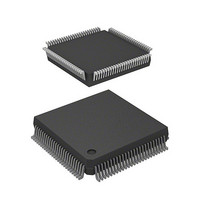D13008VXI25V Renesas Electronics America, D13008VXI25V Datasheet - Page 444

D13008VXI25V
Manufacturer Part Number
D13008VXI25V
Description
MCU 3V 0K I-TEMP PB-FREE 100-TQF
Manufacturer
Renesas Electronics America
Series
H8® H8/300Hr
Specifications of D13008VXI25V
Core Processor
H8/300H
Core Size
16-Bit
Speed
25MHz
Connectivity
SCI, SmartCard
Peripherals
PWM, WDT
Number Of I /o
35
Program Memory Type
ROMless
Ram Size
4K x 8
Voltage - Supply (vcc/vdd)
3 V ~ 3.6 V
Data Converters
A/D 8x10b; D/A 2x8b
Oscillator Type
Internal
Operating Temperature
-20°C ~ 75°C
Package / Case
100-TQFP, 100-VQFP
Lead Free Status / RoHS Status
Lead free / RoHS Compliant
Eeprom Size
-
Program Memory Size
-
- Current page: 444 of 688
- Download datasheet (4Mb)
13. Smart Card Interface
13.3.6
Initialization: Before transmitting or receiving data, the smart card interface must be initialized as
described below. Initialization is also necessary when switching from transmit mode to receive
mode, or vice versa.
1. Clear the TE and RE bits to 0 in the serial control register (SCR).
2. Clear error flags ERS, PER, and ORER to 0 in the serial status register (SSR).
3. Set the parity bit (O/E) and baud rate generator select bits (CKS1 and CKS0) in the serial
4. Set the SMIF, SDIR, and SINV bits in the smart card mode register (SCMR).
5. Set a value corresponding to the desired bit rate in the bit rate register (BRR).
6. Set the CKE0 bit in SCR. Clear the TIE, RIE, TE, RE, MPIE, TEIE, and CKE1 bits to 0. If the
7. Wait at least one bit interval, then set the TIE, RIE, TE, and RE bits in SCR. Do not set the TE
Transmitting Serial Data: As data transmission in smart card mode involves error signal
sampling and retransmission processing, the processing procedure is different from that for the
normal SCI. Figure 13.5 shows a sample transmission processing flowchart.
1. Perform smart card interface mode initialization as described in Initialization above.
2. Check that the ERS error flag is cleared to 0 in SSR.
3. Repeat steps 2 and 3 until it can be confirmed that the TEND flag is set to 1 in SSR.
4. Write the transmit data in TDR, clear the TDRE flag to 0, and perform the transmit operation.
5. To continue transmitting data, go back to step 2.
6. To end transmission, clear the TE bit to 0.
The above processing may include interrupt handling.
If transmission ends and the TEND flag is set to 1 while the TIE bit is set to 1 and interrupt
requests are enabled, a transmit-data-empty interrupt (TXI) will be requested. If an error occurs in
transmission and the ERS flag is set to 1 while the RIE bit is set to 1 and interrupt requests are
enabled, a transmit/receive-error interrupt (ERI) will be requested.
The timing of TEND flag setting depends on the GM bit in SMR.
Rev.4.00 Aug. 20, 2007 Page 398 of 638
REJ09B0395-0400
mode register (SMR). Clear the C/A, CHR, and MP bits to 0, and set the STOP and PE bits to
1.
When the SMIF bit is set to 1, the TxD pin and RxD pin are both switched from port to SCI
pin functions and go to the high-impedance state.
CKE0 bit is set to 1, the clock is output from the SCK pin.
bit and RE bit at the same time, except for self-diagnosis.
The TEND flag is cleared to 0.
Transmitting and Receiving Data
Related parts for D13008VXI25V
Image
Part Number
Description
Manufacturer
Datasheet
Request
R

Part Number:
Description:
KIT STARTER FOR M16C/29
Manufacturer:
Renesas Electronics America
Datasheet:

Part Number:
Description:
KIT STARTER FOR R8C/2D
Manufacturer:
Renesas Electronics America
Datasheet:

Part Number:
Description:
R0K33062P STARTER KIT
Manufacturer:
Renesas Electronics America
Datasheet:

Part Number:
Description:
KIT STARTER FOR R8C/23 E8A
Manufacturer:
Renesas Electronics America
Datasheet:

Part Number:
Description:
KIT STARTER FOR R8C/25
Manufacturer:
Renesas Electronics America
Datasheet:

Part Number:
Description:
KIT STARTER H8S2456 SHARPE DSPLY
Manufacturer:
Renesas Electronics America
Datasheet:

Part Number:
Description:
KIT STARTER FOR R8C38C
Manufacturer:
Renesas Electronics America
Datasheet:

Part Number:
Description:
KIT STARTER FOR R8C35C
Manufacturer:
Renesas Electronics America
Datasheet:

Part Number:
Description:
KIT STARTER FOR R8CL3AC+LCD APPS
Manufacturer:
Renesas Electronics America
Datasheet:

Part Number:
Description:
KIT STARTER FOR RX610
Manufacturer:
Renesas Electronics America
Datasheet:

Part Number:
Description:
KIT STARTER FOR R32C/118
Manufacturer:
Renesas Electronics America
Datasheet:

Part Number:
Description:
KIT DEV RSK-R8C/26-29
Manufacturer:
Renesas Electronics America
Datasheet:

Part Number:
Description:
KIT STARTER FOR SH7124
Manufacturer:
Renesas Electronics America
Datasheet:

Part Number:
Description:
KIT STARTER FOR H8SX/1622
Manufacturer:
Renesas Electronics America
Datasheet:

Part Number:
Description:
KIT DEV FOR SH7203
Manufacturer:
Renesas Electronics America
Datasheet:










